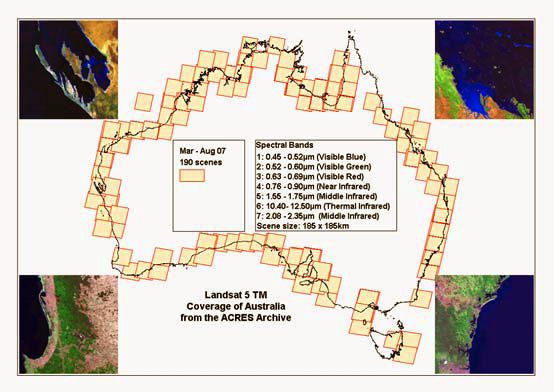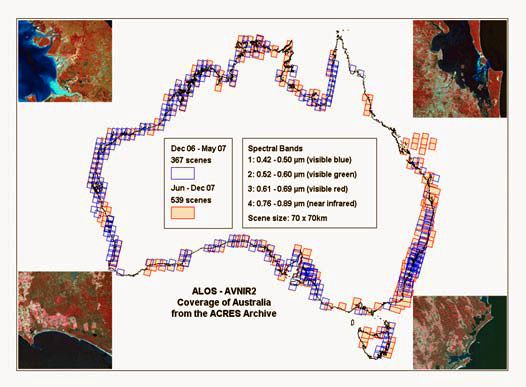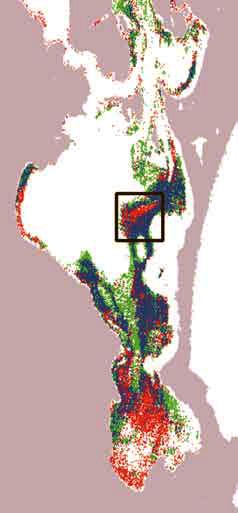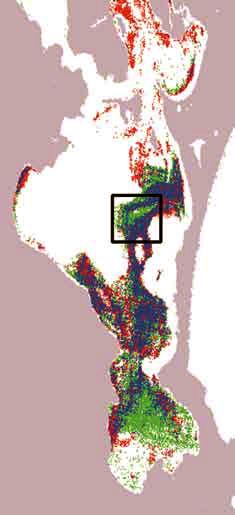Geoscience Australia (GA) has recently purchased two ASD FieldSpec® HandHeld Pro spectroradiometers as part of the Remote Sensing for Coastal Habitat Extent, Condition and Trend Assessment project, funded by the National Land and Water Resource Audit. The spectroradiometers are complete with a range of foreoptics and ancillaries for conducting measurements of spectral radiance, irradiance and reflectance for both field-based data acquisition and laboratory samples. Foreoptic options include cosine-response hemispherical diffusers for measuring sky irradiance, and 7.5 deg field-of-view (FOV) lenses for radiance and reflectance measurements. GA also operates the Australian Centre for Remote Sensing (ACRES) through which it acquires satellite data from a number of Earth Observation satellites including Landsat and ALOS. Data from these satellites, along with other sources such as Quickbird, Ikonos, SPOT are useful for mapping coastal habitat extent and trends. The satellite data archive at GA goes back to late 1970s. Therefore changes can be mapped on decadal time scales.

Figure 1a. Shows the coastal coverage of Landsat and ALOS data in GA Remote Sensing archive over a period of six months.

Figure 1b. National availability of cloud free coastal Landsat and ALOS optical images acquired over a period of six months.
What is the service?
GA maintains the spectroradiometers and will make them available to eligible researchers across the country for use in the collection of field spectral measurements. Geoscience Australia can also coordinate the acquisition of satellite data where possible, subject to researchers meeting additional expenses, synchronous with the field data measurements.
Why do we need the service?
In recent times, there have been significant advances in the development of methods supporting more consistent approaches to the classification of habitat condition and extent based on remote sensing (see NISB classification). A number of unresolved bottlenecks to the application of these methods to the coastal waters surrounding Australia have been addressed in projects funded by the National Land and Water Resources Audit and elsewhere. The most critical issue is access to consistent spectral signature libraries of the Australian shallow waters and habitats. Spectral signature libraries are catalogues of the spectral optical properties or responses of target species and other elements in terrestrial or aquatic environments of interest. These spectral signatures drive the algorithms that enable the extraction of quantitative habitat information from multi- and hyper-spectral remote sensing imagery. The spectral signatures are a fundamental property of target species and this information can only be obtained through direct measurement, generally by in-situ or sampling methods. Field work is also required to link spectral information on key species and optical water column constituents with other information such as species location, health and abundance, background target data (for differentiation within an image) and other attributes.
Field spectral measurements are critical for calibration and validation of information products derived from satellite data. Australia’s capacity for marine habitat classification derived from satellite imagery will be enhanced through the purchase of the ASD FieldSpec® HandHeld Pro spectroradiometers because there will be greater (and national-scale) access to this much needed equipment. The instruments measure light in the visible and near IR [325-1075nm] region which is comparable to the bandwidths of Landsat and ALOS sensors. Researchers will contribute the baseline datasets to the national library and these datasets will be used to derive information products that report on condition and trends in coastal habitat extent and water quality (See Case Study; Figure 2). More information on remote sensing can be found in the Remote Sensing Toolkit.
How to access the service?
The spectroradiometers are available for loan to university researchers, and to officers from local, state and federal government departments. Loan forms are to be completed, and submitted to the GA contact officer at least 12 weeks prior to the field work. The loan forms document the loan period, proposed research work, study area, acquisition dates, time-frame for providing processed spectral signatures with relevant metadata. Any potential conflicting dates between borrowers will be resolved through negotiations with the users.
Case Study: Habitat Trend Mapping
The spatial change in seagrass cover (Zostera sp.) over a fourteen year period was mapped retrospectively in Wallis Lake, NSW, Australia, using the satellite Landsat imagery.
Through change detection analysis, the three main seagrass classes of interest could be assessed as declining, stable or increasing.


Figure 2. (a) Changes in Zostera cover in Wallis Lake, NSW 1988-1991. (b) Changes in Zostera cover in Wallis Lake, NSW 1991-1995 The highlighted region shows a scar where the seagrass Zostera was lost in 1991 but had re-grown by 1995. (red = loss; green = gain; blue = no change)
To illustrate the variability of change over time, a change detection map for Zostera was produced for the 1988-1991 and 1991-1995 images. The 1988-1991 change detection image (Figure 2a) clearly indicates Zostera loss from the central eastern basin. Zostera change is not uncommon and could be the result of seasonal or environmental conditions, although both images were acquired approximately in the same season (February 1988 and March 1991). By 1995 (Figure 2b), Zostera had re-grown covering the scar feature identified in 1991 (Figure 2a).
Conditions of use
- Comply with GA’s terms of hire, which includes bearing the costs of freight, insurance and repair and maintenance (if required) and ensuring that the equipment is used as per the instructions given by the manufacturer;
- Use the instruments in accordance with the standard operating procedure as set out by CSIRO Land and Water; and
- Contribute the obtained spectral data to the national spectral library without any restrictions for third party use and free distribution.
Reference:
- Dekker, A. G., Brando, V. E. and Anstee, J.M. (2005). Retrospective seagrass change detection in a shallow coastal tidal Australian lake, Remote Sensing of Environment, Vol. 97 (4), pp. 415-433.
Contacts
Dr Medhavy Thankappan
Phone: +61 2 6249 9310
Australian Centre for Remote Sensing (ACRES)
Geoscience Australia


